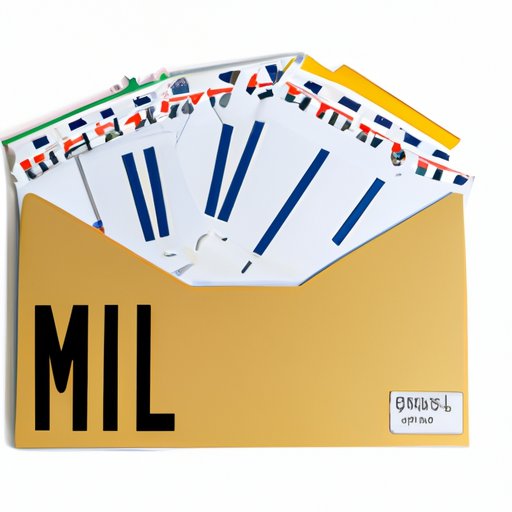I. Introduction
Do you struggle to keep track of incoming mail, both physical and digital? Whether it’s bills, personal correspondence, or junk mail, it can be overwhelming to figure out what requires your attention and what can wait. This article will explore the best strategies for seeing what mail is coming and how to stay organized so that you never miss an important letter again.
The topics that we’ll cover include methods for keeping track of your incoming mail, how to maximize your mailbox, techniques for never missing an important letter again, strategies for sorting your incoming mail, and tips for prioritizing and tracking your mail. The thesis of this article is that having an effective system for managing incoming mail is key to reducing stress and staying organized.
II. 5 Simple and Effective Methods to Keep Track of Your Incoming Mail
Here are five simple and effective methods for keeping track of your incoming mail:
Method 1: Setting up email alerts for important mail
If you receive a lot of important mail via email, consider setting up email alerts for certain senders or keywords. This will ensure that you never miss an important message.
Method 2: Using a physical inbox tray or folder system
For physical mail, use an inbox tray or folder system to keep track of incoming mail. Designate a specific spot for incoming mail, and make sure to go through it regularly.
Method 3: Developing a habit of checking your mailbox daily
Make it a habit to check your mailbox every day, whether it’s a physical mailbox or an email inbox. This will help you stay on top of incoming mail and reduce the chances of missing anything important.
Method 4: Signing up for USPS Informed Delivery
USPS Informed Delivery is a free service that sends you an email every morning with scanned images of the mail that will be delivered that day. This can be especially helpful if you’re expecting an important piece of mail or need to keep track of incoming bills.
Method 5: Utilizing digital tools like apps or online trackers
There are a variety of apps and online trackers that can help you keep track of your incoming mail, both physical and digital. Some popular options include MailTrack, ParcelTrack, and Evernote.
III. The Ultimate Guide to Staying Organized with Incoming Mail
By combining the methods outlined above, you can create an effective system for staying organized with incoming mail. However, it’s important to note that everyone’s system will be different. The key is to find what works best for you and to stick with it.
To ensure that your system is effective over time, here are some additional tips:
- Create a consistent routine for dealing with incoming mail
- Purge unnecessary mail regularly to avoid clutter
- Take advantage of tools like shredders and recycling bins to streamline the process
IV. Maximizing Your Mailbox: How to See What Mail is Coming and When
Knowing what mail is coming and when can be incredibly helpful in managing your incoming mail. Here’s how to set up USPS Informed Delivery and other tools to help you see what’s coming:
- Sign up for USPS Informed Delivery online
- Use a package tracking tool like ParcelTrack to keep track of incoming packages
- Set up email or text alerts for specific senders or keywords
V. Outsmarting Your Inbox: Techniques to Never Miss an Important Letter Again
Missing important mail can have serious consequences, such as late fees or missed deadlines. Here are some techniques to ensure that you never miss an important letter again:
- Mark important messages as “unread” until you’ve dealt with them
- Set up filters or rules to automatically sort your incoming mail
- Use a separation tool or app to separate important messages from the rest
VI. From Junk Mail to Important Invoices: The Best Strategies to Sort Your Incoming Mail
Sorting incoming mail effectively is key to staying organized and reducing stress. Here are some strategies for identifying and sorting different types of mail:
- Sort mail into different categories (e.g. bills, personal correspondence, junk mail)
- Open and deal with mail immediately whenever possible
- Create a separate system for dealing with large amounts of mail (e.g. creating a “to-do” folder)

VII. Mindful Mail Management: How to Track and Prioritize Your Incoming Correspondence
Mindful mail management is all about staying present and focused when dealing with your mail. Here are some tips for prioritizing your mail and tracking what needs attention:
- Assign priorities to different types of mail (e.g. urgent, important, non-essential)
- Create a tracking system to ensure that important messages are addressed promptly
- Use a calendar or planner to keep track of deadlines and due dates
VIII. Conclusion
In conclusion, staying organized with incoming mail is crucial for reducing stress and staying on top of important tasks. By using a combination of methods like setting up email alerts, creating a physical inbox tray, and signing up for USPS Informed Delivery, you can create an effective system for tracking your incoming mail. Additionally, staying consistent with your routine, mindful of your priorities, and proactive in dealing with incoming mail will help you stay organized over time.
(Note: Is this article not meeting your expectations? Do you have knowledge or insights to share? Unlock new opportunities and expand your reach by joining our authors team. Click Registration to join us and share your expertise with our readers.)
